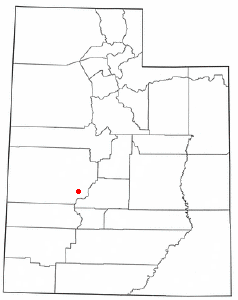Kanosh, Utah
|
|
Kanosh is a town located in Millard County, Utah. As of the 2000 census, the town had a total population of 485.
| Contents |
Geography
Kanosh is located at 38°48'1" North, 112°26'20" West (38.800193, -112.438994)Template:GR.
According to the United States Census Bureau, the town has a total area of 2.2 km² (0.9 mi²). 2.2 km² (0.9 mi²) of it is land and none of the area is covered with water.
Demographics
As of the censusTemplate:GR of 2000, there are 485 people, 165 households, and 130 families residing in the town. The population density is 220.3/km² (569.8/mi²). There are 214 housing units at an average density of 97.2/km² (251.4/mi²). The racial makeup of the town is 95.88% White, 0.00% African American, 1.03% Native American, 0.00% Asian, 0.00% Pacific Islander, 2.68% from other races, and 0.41% from two or more races. 3.71% of the population are Hispanic or Latino of any race.
There are 165 households out of which 35.2% have children under the age of 18 living with them, 73.9% are married couples living together, 4.8% have a female householder with no husband present, and 21.2% are non-families. 20.6% of all households are made up of individuals and 15.2% have someone living alone who is 65 years of age or older. The average household size is 2.94 and the average family size is 3.43.
In the town the population is spread out with 32.4% under the age of 18, 7.4% from 18 to 24, 17.1% from 25 to 44, 24.3% from 45 to 64, and 18.8% who are 65 years of age or older. The median age is 38 years. For every 100 females there are 102.1 males. For every 100 females age 18 and over, there are 100.0 males.
The median income for a household in the town is $32,411, and the median income for a family is $36,583. Males have a median income of $30,556 versus $21,500 for females. The per capita income for the town is $11,346. 17.2% of the population and 9.6% of families are below the poverty line. Out of the total population, 30.5% of those under the age of 18 and 3.3% of those 65 and older are living below the poverty line.
History
The town of Kanosh dates back to April 28, 1867 when Brigham Young, with the approval of Chief Kanosh, advised the pioneers to move from Petersburg (Hatton), Utah to the area then known as the campground of the Pahvant Tribe of Indians. When this move took place (1867-68) there were approx. 100 pioneers and 500 Native Americans living here.
At that time the Chief and many of his tribe were baptized members of the Mormon church. Mortimer Wilson Warner, a local pioneer, is credited with having suggested that the town be named Kanosh in honor of the wise tribal chief.
Chief Kanosh (1812?-1884), was the leader of the Pahvant Utes from the 1850s until the time of his death. According to Mormon records he was the son of Kashe Bats and Wah Goots. The Pahvant band ranged the deserts surrounding Sevier Lake. With the intrusion of whites into this area, Kanosh struggled to insure the hegemony and survival of his people through negotiation rather than conflict.
Kanosh was settled by Mormon pioneers and Chief Kanosh himself became an early convert to the faith. It is thought that Kanosh's willingness to work with non-Utes came out of his experiences working in the missions of California. Whether that work was voluntary or part of the long-standing slave trade of Indians into the Spanish settlements is not known. Certainly, the physical characteristics of Kanosh and others of the "Bearded Utes," as Escalante had called the Pahvants in the 1770s, suggest generations of contact with the Spaniards. Kanosh spoke Spanish and seems to have had a facility for languages, as he also easily picked up English.
Over time, the Kanosh tribe dwindled both due to difficulty in adapting to a farming culture from a hunter-gathering culture and in intermarriage with the local settlers. Even though many of the natives were deeded farmland, most chose to abandon the lifestyle and accept a government offer to move into the Uinta reservation where they would receive economic assistance.
However, the Pahvants at Corn Creek, a settlement established near Kanosh, continued to farm. Surrounding Mormon settlers gave them some assistance. And although Kanosh was involved in the negotiations of the 1865 Spanish Fork treaty in which Utes agreed to move to the Uinta Basin, Kanosh and his group continued at Corn Creek until a grasshopper invasion in 1868 destroyed most of their crops. Even then, Kanosh and his people did not always remain in the Uinta Basin; they returned often to Corn Creek to farm, forage, and beg from Mormon settlers.
While Chief Kanosh is buried in the most honored location of the city cemetary, it was not until 1929 that the U.S. Government granted official recognition of the tribe and deeded them a small reserve near their ancestral lands at Corn Creek. What few tribal members remain today have now been almost fully assimilated into the local culture shaped by agriculture, ranching and the Mormon faith.
Kanosh was adversely affected by atomic testing in the Nevada desert in the late 1950's and early 1960's, with many residents and former residents developing cancerous symptoms years later. In response and after years of effort by Utah's congressional delegation, the U.S. Congress passed the Radiation Exposure and Compensation Act of 2000 to provide minimal compensation for those thus affected.
External links
Template:Mapit-US-cityscale History: http://www.onlineutah.com/kanoshhistory.shtml, http://www.greatbasinheritage.org/kanosh.htm

